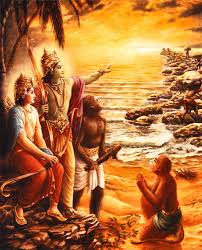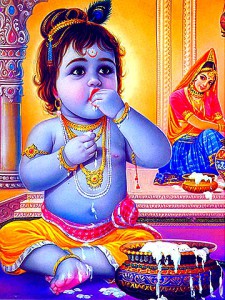Introduction: The Setting of Kāmyavana
Kāmyavana is one of the twelve sacred forests of Vṛndāvana, where Lord Kṛṣṇa performed many of His divine pastimes. One such pastime occurred at a lake known as Setu-Bandha Kuṇḍa. On a hot summer day, Kṛṣṇa, along with Rādhā and the Gopīs, sought the cool breeze by the shore of the lake. As they rested and enjoyed the soothing air, their attention was drawn to the playful antics of the monkeys nearby.
The Monkeys and Kṛṣṇa
The monkeys, a common sight in Vṛndāvana, were frolicking in the water, swimming, and playfully splashing about. Their cute behavior delighted the Gopīs, who watched them with amusement. One particularly endearing monkey caught everyone’s attention by jumping out of the water, picking up Kṛṣṇa’s toes, and placing them on his head in an act of devotion. The Gopīs were charmed by this gesture and began to laugh, commenting on how the monkeys’ friendship with Kṛṣṇa reminded them of Lord Rāma’s bond with the monkeys during His incarnation as the son of Dasharatha.
Kṛṣṇa’s Playful Jealousy
Hearing the Gopīs compare Him to Lord Rāma, Kṛṣṇa couldn’t resist joining the conversation. He proudly declared, “Hey, hey, wait! I am Rāma. I really am the son of Dasharatha!” The Gopīs, unable to contain their laughter, teased Him, saying, “Sure, you’re Rāma! But you’re just a cowherd boy who plays the flute and runs when your mother calls. How could you be the great Kṣatriya Rāma?”
Lalitā, one of the Gopīs, challenged Kṛṣṇa, saying, “If you really are the leader of the monkeys like Rāma, then take these monkeys and build a floating bridge across this lake—just like Rāma did across the ocean.”
Kṛṣṇa’s Response: Building the Bridge
The Ācāryas comment that although the monkeys were mischievous and restless, Kṛṣṇa was not deterred by the Gopīs’ challenge. To prove His point, He took out His beloved flute and played a melody that enchanted the monkeys. The moment they heard the flute, the monkeys became calm and submissive, much like children lining up quietly in response to their teacher’s call.
The monkeys, now obedient and eager to serve, began gathering stones from Kāmyavana and placing them at Kṛṣṇa’s lotus feet. Viśākā, another Gopī, picked up one of the stones and sarcastically remarked, “Let’s see if this stone will float like in Rāma’s bridge.” She threw the stone into the lake, and it immediately sank to the bottom.
Kṛṣṇa, with a knowing smile, placed His lotus foot on another stone and instructed the monkeys to throw it into the lake. This time, the stone floated. The Gopīs were stunned and momentarily embarrassed as they realized that Kṛṣṇa had indeed accomplished the impossible, just like Rāma.
Victory and Humility
The monkeys continued to throw stones into the lake, and soon a floating bridge was formed. The monkeys were overjoyed, running back and forth across the bridge, chattering and playing with great pride in their accomplishment. The Gopīs, though initially speechless, were also filled with admiration for Kṛṣṇa’s divine prowess.
In a show of respect, they stood up, raised their arms, and chanted, “Jay Śrī Rāma, Jay Śrī Rāma, Jay Śrī Rāma!” However, Kṛṣṇa, demonstrating the humility befitting a true leader, folded His hands and bowed at the lotus feet of Śrīmatī Rādhārāṇī, acknowledging Her as the supreme controller of Vṛndāvana and His heart.
Kṛṣṇa and Rādhā’s Walk
With the bridge completed and the monkeys and Gopīs busy with their activities, Kṛṣṇa took Śrīmatī Rādhārāṇī’s hand and suggested they walk across the bridge together. They crossed the lake, enjoying a peaceful moment together, as the entire forest of Kāmyavana resonated with their divine love.
Lessons to be Learned:
- Divine Playfulness and Devotion: Kṛṣṇa’s playful interactions with the Gopīs and the monkeys remind us that even the Supreme Lord enjoys light-hearted exchanges with His devotees. Devotion to Kṛṣṇa can be filled with joy, laughter, and playfulness, as it deepens our relationship with Him.
- The Power of the Holy Name: Kṛṣṇa’s flute represents the divine sound of the Holy Name, which can calm the most restless of beings and inspire them to serve the Lord with devotion. The story teaches us the transformative power of the Holy Name in bringing harmony and devotion into our lives.
- Humility in Greatness: Despite His supreme power and the respect He commands, Kṛṣṇa exhibits humility by bowing to Śrīmatī Rādhārāṇī. True greatness lies in acknowledging the source of one’s strength and offering respect where it is due.
- The Joy of Surrender: The Gopīs initially challenged Kṛṣṇa, only to be amazed by His divine abilities. Their eventual surrender and praise of Kṛṣṇa as Śrī Rāma highlight the bliss that comes from surrendering to the Lord’s will and recognizing His supremacy.
Quote from Śāstra:
“Whatever a man may sacrifice to other gods, O son of Kunti, is really meant for Me alone, but it is offered without true understanding.”
— Bhagavad Gītā 9.23
This verse reminds us that all acts of devotion, whether directed to Rāma or Kṛṣṇa, ultimately reach the Supreme Lord, who is the source of all incarnations.
Prayer:
O Lord Kṛṣṇa, we offer our humble obeisances to You, who are the source of all divine incarnations. May we always be immersed in Your loving service, filled with the joy and playfulness that comes from pure devotion. Grant us the wisdom to recognize Your divine presence in all forms and to surrender to Your will with humility and grace. May we always cherish the sweet sound of Your Holy Name and follow in the footsteps of Your beloved Gopīs, who taught us the beauty of love and surrender. Jai Śrī Kṛṣṇa! Jai Śrī Rādhā! Jai Śrī Rāma!



